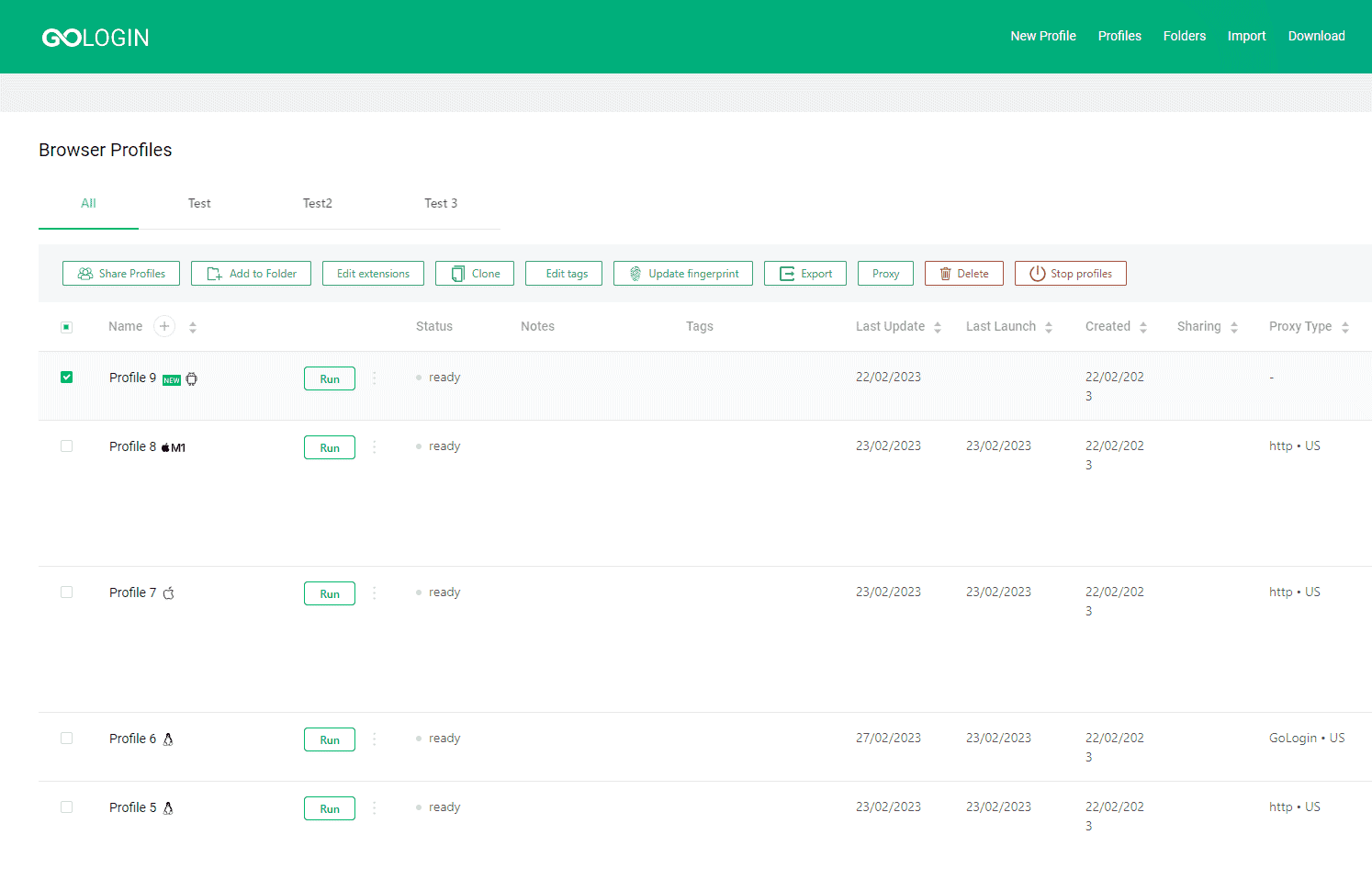
GoLogin Review
GoLogin has affordable pricing plans and a very active development team.
Use the code PROXYWAY to get a 50% discount on your first purchase.
GoLogin joined the antidetect browser market in 2019. Marketers use the tool to manage multiple social media accounts, retailers – to create stealth profiles, while others run several ad accounts. And today, you wouldn’t find a listicle without this tool in the top three positions.
Sometimes GoLogin is considered to be a cheaper Multilogin version. And that’s not a lie – it’s a relatively good tool performance and feature-wise, but at a much more affordable price. So, if you want to save a buck or two and don’t mind slower load speed, GoLogin is worth considering.
In this review, we’ll take a closer look at GoLogin’s features, price, user experience, and performance to see if it’s a good fit for you.
General Information
| Country | US |
| Founded | 2019 |
| Operating systems | Windows, macOS, Linux, Android, cloud |
| Starting price | $49/month (or $24 if paid yearly) |
| Payment methods | Debit or credit card, PayPal, cryptocurrencies |
| Trial | 7 days or Forever Free account with 3 profiles |
GoLogin is a US-based company with headquarters in New York. Its primary focus is a multi-accounting browser that allows controlling bulk profiles from a web cloud browser or a local app.
Even though the company hasn’t been in the market very long, it’s managed to build an impressive community of users. According to its website, over the years GoLogin has had over 350 thousand users and 2.5 million profiles created. If the numbers are valid, this makes the company one of the more popular options among antidetect browsers.
GoLogin positions itself as an affordable service – it offers lower prices than many competitors. The company targets a broad spectrum of users – from individuals to large clients looking to scale up.
The company has active Twitter, Facebook, LinkedIn, Telegram, and YouTube accounts. It posts every while and then, mostly focusing on Twitter, replying and sharing tips across the platform.
GoLogin puts extra effort into making proxy integration as easy as possible. It’s the only service to offer free and paid proxies for a safe browsing experience. You’ll also find step-by-step videos on integrating the top proxy provider services with GoLogin.
However, knowing that anonymity services are a legal-grey area in the eyes of many, I’ve found it strange that GoLogin doesn’t require a know-your-customer procedure. That raises some serious questions about ethical browsing – can the company position itself as a trustworthy service if it doesn’t vet its customers?
GoLogin Features
Antidetect browser packed with all the necessary features for bulk account management.
GoLogin is an antidetect browser that lets you create and manage multiple website browser profiles. Each profile comes with its own digital browser fingerprint. The tool is packed up with other features that are handy for multi-accounting. Let’s delve into them.
Free and Paid Proxies (+ Proxy Service Support)
GoLogin stands out from the competition by offering free proxy traffic. Paid users can choose from three types of proxies and get:
- 500Mbs of residential proxy traffic;
- 500Mbs of mobile proxy traffic;
- 6GBs of datacenter proxy traffic.
What’s more, even the free trial and the Forever Free plan come with 3GBs of free datacenter proxy traffic. If free proxies aren’t enough, you can buy additional traffic by paying $3/GB for residential and mobile proxies, or $2/GB for datacenter IPs.
You can choose IPs from around 80 countries (depending on the type of proxy), including popular locations like the USA, Canada, Germany, the UK, and India:
- Residential proxies: 78 countries;
- Mobile proxies: 63 countries;
- Datacenter proxies: 22 countries.
You can also opt for a free Tor network. If that’s not enough and you need to scale up, there’s an option to use your own proxy – the tool supports HTTP, SOCKS4, and SOCKS5 protocols.
Default Profile Setting (+ Ability to Customize Each Setting)
GoLogin allows creating a template with default settings. This is especially useful if you need to create profiles in bulk with the same configurations.
The default profile setting allows customizing language, minimal/maximum screen resolution, and the operating system. So, the next time you’ll create a new profile, it’ll automatically set up one with the configured settings.
However, if you want to add proxies, change timezone, or user-agent, you’ll have to do that manually.
Team Collaboration
GoLogin lets you share and manage your profiles with other people. You can give access to one or several profiles, and assign different permissions to each member – to edit, manage, or only view those profiles.
Additionally, you can transfer your profiles to another account, but you’ll lose your managerial rights. For example, if your teammate takes over a client and you need to view the profile, you’ll have to ask for a viewing permission.
Bulk Account Management
GoLogin also supports the ability to manage several profiles at the same time. By choosing one or a group of profiles, you can clone, delete, add to folders, or share them with other people.
What’s more, you can easily change the fingerprint for each profile. For example, if you need several profiles with the same configurations, you can clone them and give each a unique fingerprint. This can save a lot of time.
API integration
If you want to automate your actions, GoLogin offers an API that integrates with other programs and headless libraries. You can programmatically create, manage, and otherwise customize the profiles. It’s even possible to automate posting, following, and liking on social media platforms.
Additionally, GoLogin profiles can be used to automate browser interactions with Selenium and Puppeteer headless libraries. For example, you can automate your workflow by filling forms, logging in, or taking screenshots.
Mobile Browser Profile
With GoLogin you can launch a profile using a mobile browser by choosing Android as your operating system. This functionality will make it look like you’re visiting from a mobile device.
In a nutshell, websites are reluctant to block users that connect from mobile devices because they might block a bunch of them. So, in case you need extra safety, connecting as a mobile phone user might save you from losing your profiles.
Cloud and Local Application
GoLogin is available in both a cloud web version and a local application. The former launches a browser on GoLogin’s server and streams it via a tab, but it’s still an experimental feature. The latter automatically opens Orbita as your browser. It doesn’t matter which one you use; the cloud and app are synched – whenever you create a profile or change the settings, it’ll appear on the other one.
When several people with different computers use an antidetect browser, a virtual machine is the safest way to control it. So, GoLogin gives you one by default. Also, you can use your profiles across different devices.
Additionally, local applications typically run faster than web ones. This could benefit you if you need to perform resource-intensive tasks like running multiple accounts simultaneously.
Customized Browser
GoLogin controls a customized browser engine Orbita built upon Chromium. The browser interface is very similar to Chrome, with some minor differences like the profile’s name by the address bar.
It uses warpcore technology that allows you to run profiles with different Orbita versions and the corresponding version of the browser engine. In simple words, it keeps your virtual browser up to date.
Additional Perks
GoLogin has more features that come with the service:
- Pre-installed extensions and support for Chrome browser extensions.
- Encrypted profiles for additional security.
- Ability to import and export cookies using third-party Chrome extensions.
- Cookie robot to collect cookies from specific URLs.
GoLogin Pricing
Cheap plans tailored to single users and large companies alike.
GoLogin runs on a subscription-based pricing model that automatically renews every month until you cancel it. There’s an option to commit to a yearly subscription, and that will save you 50%.
Over time, GoLogin kept good quality at a lower-than-average price. Its cheapest plan starts at $49 (or $24 if paid yearly), twice cheaper than its main competition Multilogin. And I think an attractive price is the main driver of this service. The other plans cost $99 and $199 per month. Also, there’s a custom plan which costs from $299 to $1999.
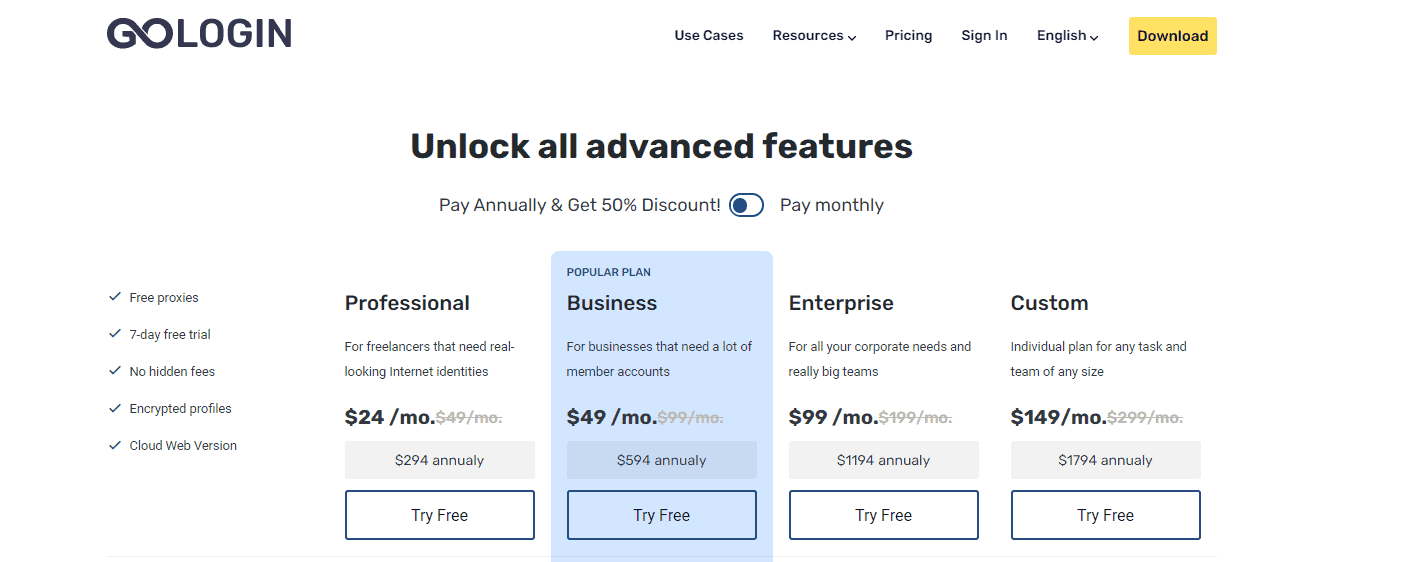
All plans include the same features, but there are four major differences:
- Number of browser profiles you can create. The plans give you 100, 300, 1,000, and from 2,000 to 10,000 browser profiles.
- Profile sharing options. The number of times when you can share browser profiles: 10, 100, 1,000, and 2,000
- Collaboration between team members. You won’t be able to collaborate between teams with the entry plan. The other plans come with 10 and 20 seats.
- Cloud launches. The number of profiles you can run in the cloud without installing the app varies between 2 and 40.
Forever Free Plan
If you’re not planning on running hundreds of profiles, GoLogin offers a free plan that includes three profiles and all the features except for sharing and team members.
You can opt for a paid plan at any time, or try the tool for 7 days at full capacity before the purchase.
GoLogin Performance Tests
Consistent browser fingerprint on the local app.
We tested GoLogin with two targets: Pixelscan and CreepJs. The tests ran on a Windows computer with 1) automatically generated browser fingerprints, 2) using two residential proxy providers with sticky IPs, and GoLogin’s free proxies.
Pixelscan is a tool for checking fingerprint inconsistencies. It goes through software, hardware, and IP irregularities, and shows whether your profile is trustworthy. Even though GoLogin has an in-built checker, we wanted to do some extra digging.
CreepJS is more gruesome in terms of spotting fingerprint weaknesses. The tool shows exact inconsistencies and outlines them in the results. It uses percentage-based scoring from 0% to 100%.
Here are the results:
| Pixelscan check | CreepJS score (108) | CreepJS score (109) | |
| Profile 1 (Windows) | ✅ | 68.5% | 63% |
| Profile 2 (Windows) | ✅ | 68.5% | 63% |
| Profile 3 (Windows, GoLogin free US proxy) | ✅ | 68.5% | 63% |
| Profile 4 (Windows) | ✅ | 68.5% | 63% |
| Profile 5 (Windows) | ✅ | 68.5% | 63% |
| Profile 6 (Linux) | ❌ | 71.5% | 66% |
| Profile 7 (macOS) | ❌ | 68.5% | 63% |
| Profile 8 (macOS M1) | ❌ | 68.5% | 63% |
| Profile 9 (Android) | ❌ | 71.5% | 66% |
GoLogin passed the Pixelscan check when using Windows. It only failed with profiles that mismatched our operating system. And predictably so, since using the same operating system as your actual one is recommended to make the fingerprint more consistent.
We also ran the tests on the cloud browser. However, GoLogin is still experimenting with this version, so the test was unsuccessful.
The provider did relatively well with CreepJS; however, there were some technical issues. We ran the test using the web browser because the local app couldn’t fully load the results.
We used two Orbita versions: the latest (109), and an older version (108). And the reason is that the latest update had inconsistencies with the user agent, as it’s sending two different user agent strings, one indicating version 19 of the browser and another – version 18. Consequently, the older version returned better results. After I opened the app, there was a screaming message to update all the profiles to the latest version.
It’s worth highlighting since GoLogin’s servers run on Linux-based systems, the tool performed better with Linux-mimicking profiles. All the other profiles had one thing in common – they couldn’t fully pass the trash challenge, saying, system and fonts are suspicious.
All in all, we’re happy with GoLogin’s results – it’s fully capable of providing a consistent fingerprint, and the score on CreepJS was better than average.
How to Use GoLogin
Intuitive user interface with many single-click editing options.
Registration & Subscription Management
There are two ways to register on GoLogin.
The first one is pretty straightforward. You can create an account via the website or the app under the sign-in option. After doing so, you’ll be forwarded to the dashboard. The web version and app are linked together.
If you already know what plan you need, you can go straight to the pricing, and try out a plan of your choice for free (7 days). Interestingly, there’s no option actually to buy it. Your browser will automatically start downloading the GoLogin app, which is weird because you don’t get the chance to register first. After you’re finished setting up (it takes around a minute), the registration process is then the same; you just have to do everything from the app installed on your computer.
User Interface
GoLogin has a very minimalist dashboard. But that’s mainly because all the functionality is hidden under separate sections.
The app’s navigation includes four tabs for: instantly creating a new profile, viewing all the profiles, creating folders, and importing profiles from a CSV file. Here, you can also find your profile settings and a quick four-step guide on using the tool. The main one, of course, is profiles, from which you can manage all your activities. Additionally, the web version includes an extra tab for downloading the app.
GoLogin puts extra effort to ensure flawless user experience. And hands down it wins even against some premium tools like Multilogin. It allows you to look up the last launch and update, creation date, on what operating system a certain profile is running, its status, and all the information about the proxy you’re using. You can manually update any of the settings. Also, you can make notes and create tags, which comes in handy when collaborating with other people. If you don’t need a specific editing field, you can simply switch it off.
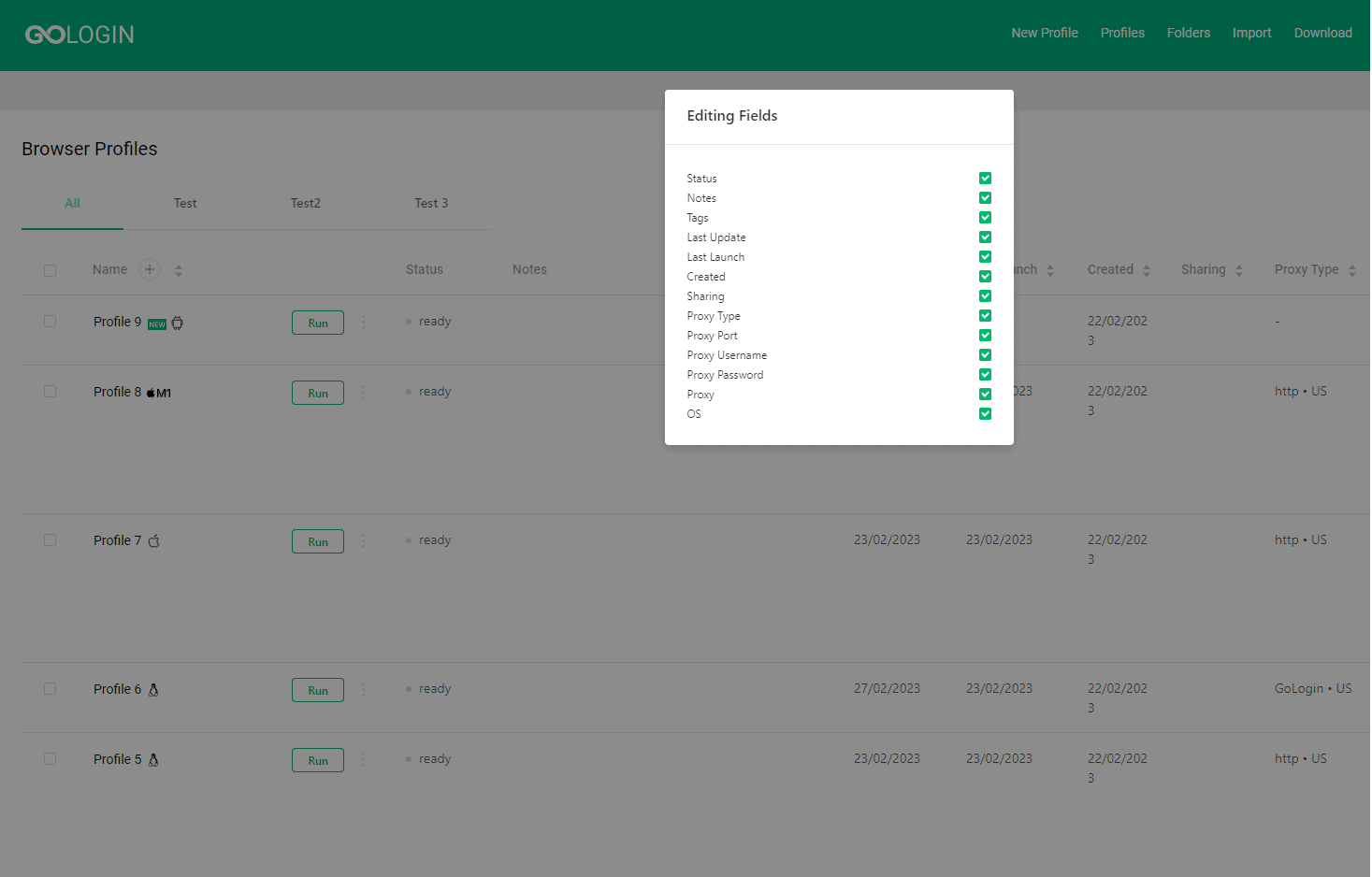
The user interface for running a profile is very similar to Chrome. The main difference comes down to your profile’s name by the address bar. This is really helpful when juggling multiple profiles. Since GoLogin offers two ways to use the tool – a browser and an app – there are some things worth highlighting.
If you’re using a web browser, running a profile will open an additional tab, which will be your antidetect browser. It will line up next to your other tabs – if you had any of them opened previously. However, the display resolution lacks quality, and the browser speed is slow. When I’ve tested the tool, I also encountered some technical issues – sometimes it didn’t open the tab, or when it did, instead of letters I had to deal with weird symbols.
With the desktop app, on the other hand, you’ll first be required to download GoLogin’s customized browser Orbita. After you’re done with the installation (the process takes place in the app automatically, so there’s no need to go and download the browser separately), you can launch your profile, which automatically opens in the virtual browser. However, I’ve noticed that it takes time to launch Orbita (sometimes up to two minutes!), so be patient.
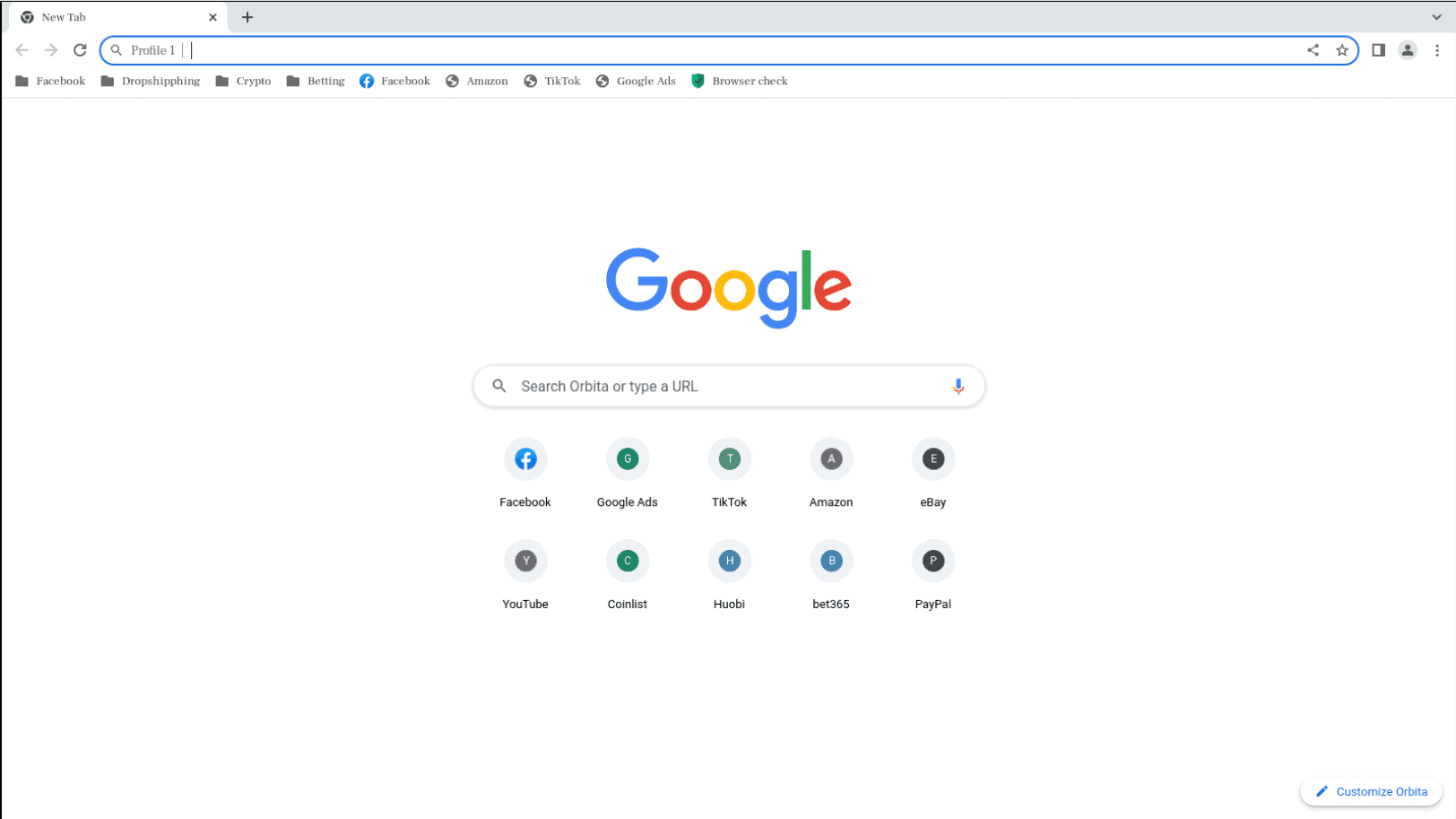
Creating and Managing Profiles
GoLogin allows you to create a profile through the navigation tab or to add one with a single click next to the profile names column.
You can create a new profile through the navigation bar under “New Profile”. It’s pretty basic, and you instantly get access to modifying the settings that make a browser fingerprint. For example, the operating system, proxies, timezone, and screen resolution, among others. Also, there’s a button for generating a new fingerprint which changes resolution, language, fonts, and devices. Additionally, GoLogin offers a sidebar for your profile summary.
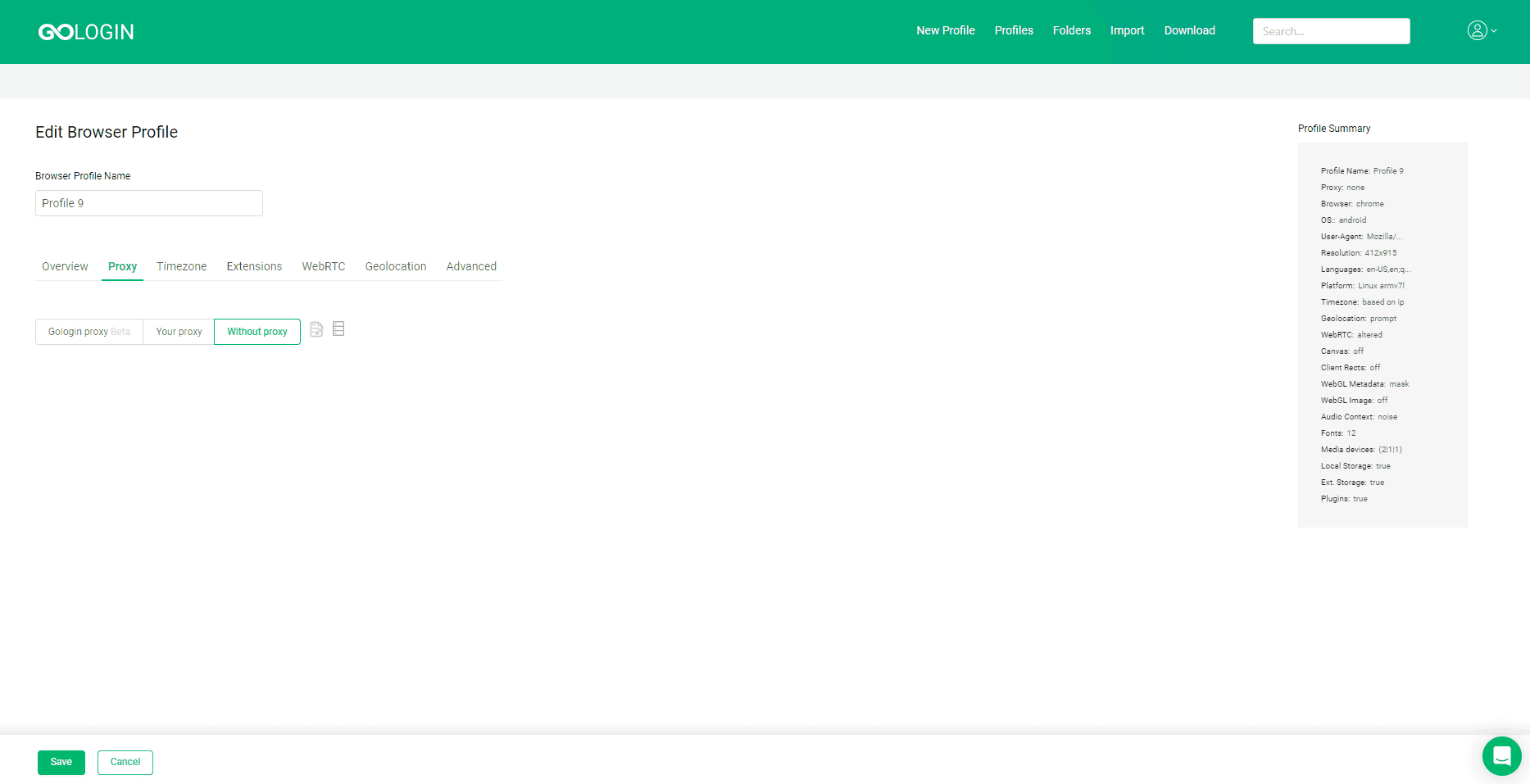
After you’re done creating your profiles, you can start organizing them. The browser management bar appears when you select a profile. You can assign to different folders, share with team members, and assign viewing, editing or admin rights. Also, you can edit extensions, clone the profile, and update the fingerprint.
Then there’s another set of functions hidden under the three dotted lines, some overlapping. It’s worth highlighting that here you can find the “Settings” parameter which will take you to the main editing window.
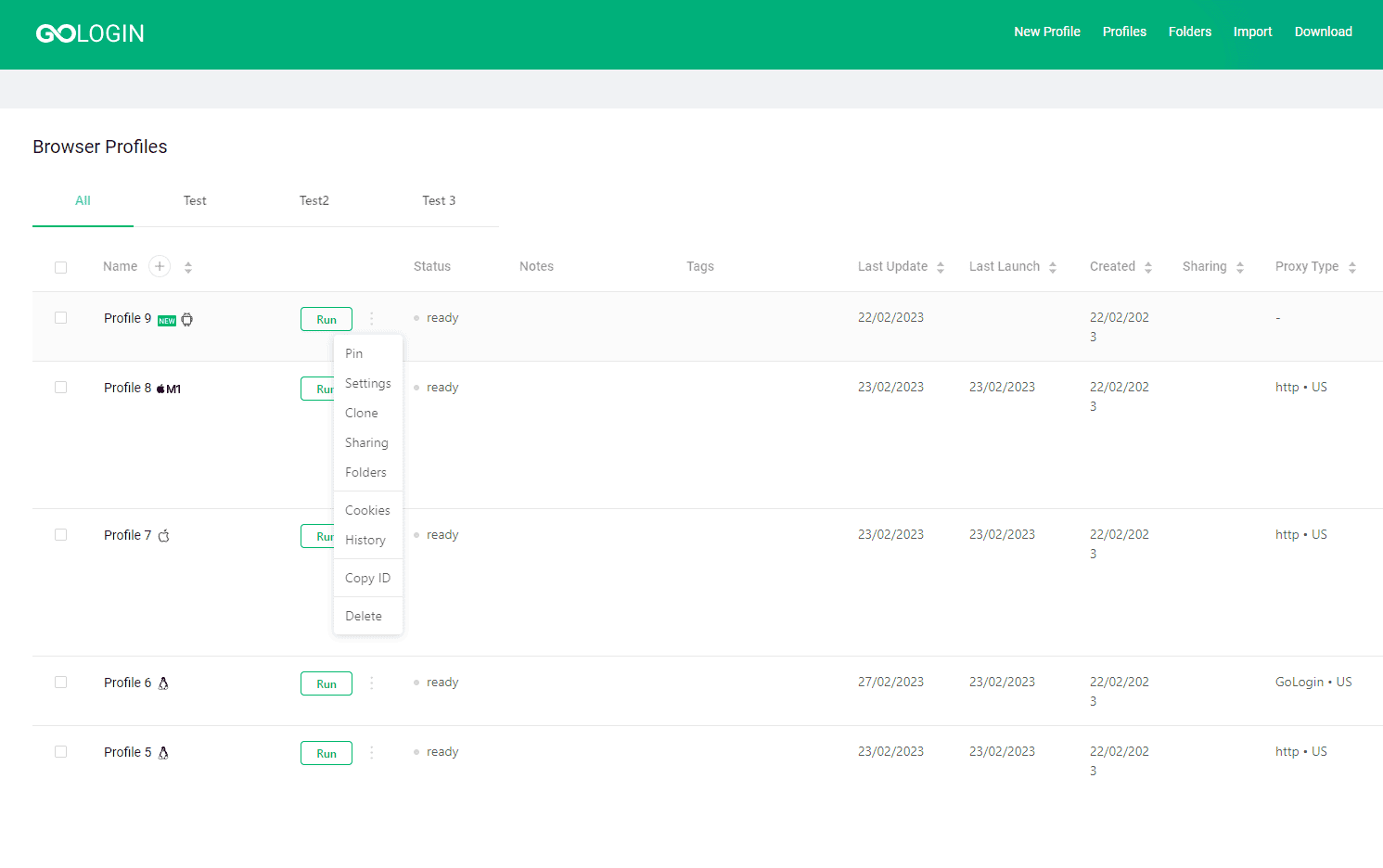
GoLogin has a handy feature for quick profile settings. It opens an additional sidebar with basic configurations like proxy, language, timezone, and others. You can also assign your profile to a folder here, or add some notes. If needed, there’s an option to refresh the fingerprint with a single click. However, it’s only recommended if the current one has been compromised.
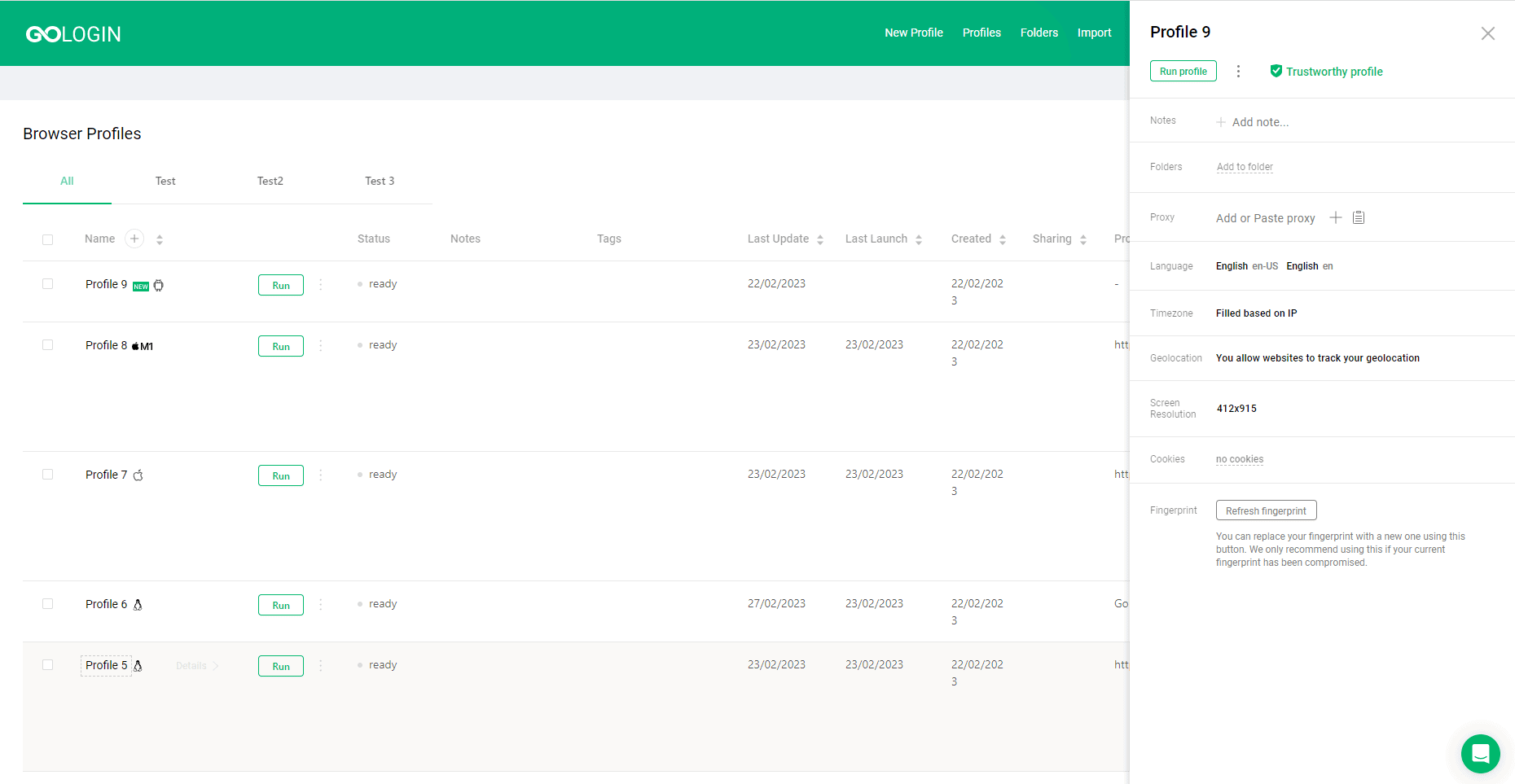
GoLogin offers a Cookie manager where you can easily import them from a file or a text. But that’s pretty much it for this feature.
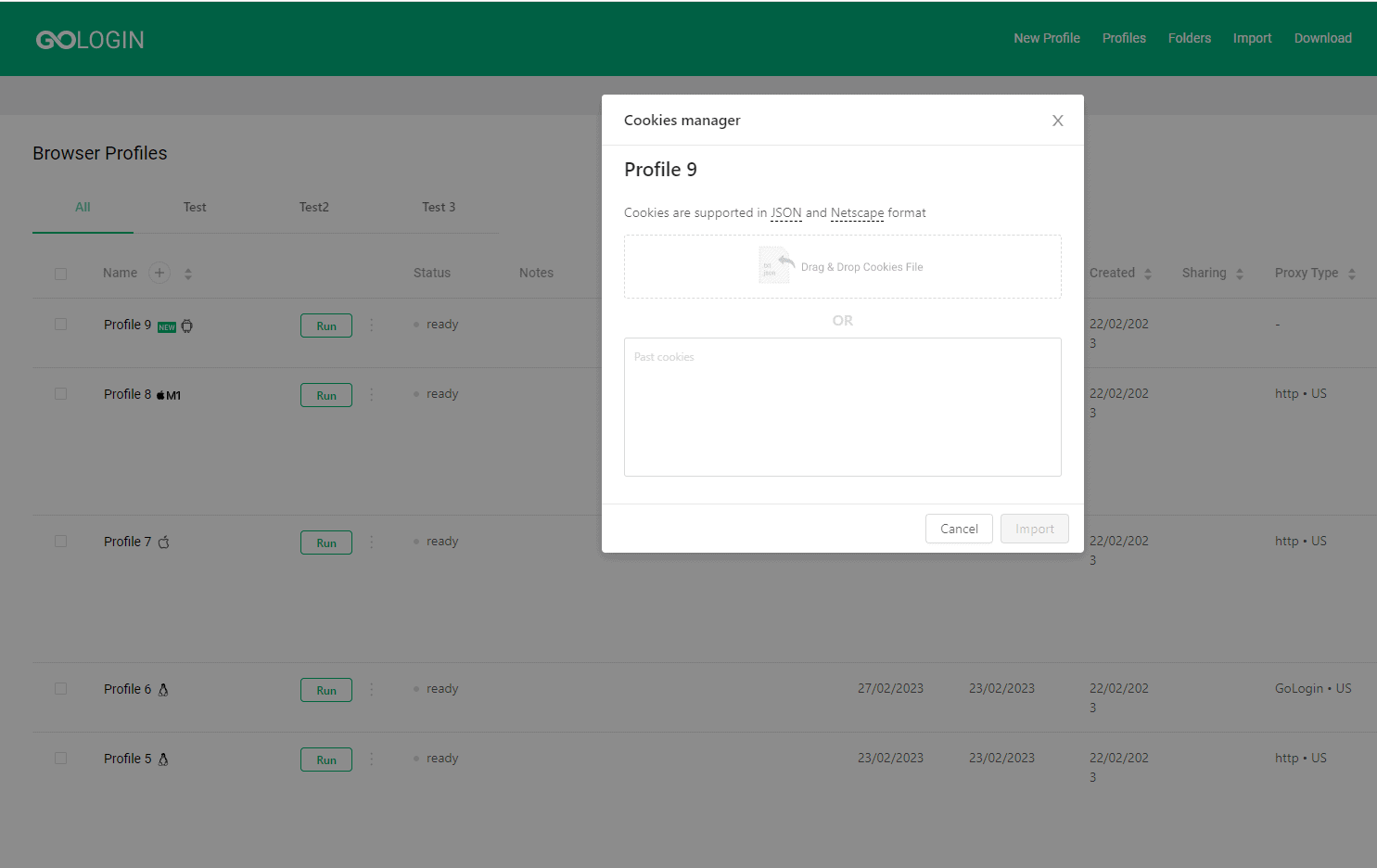
Additionally, if you need throwaway sessions, you can generate a profile with a single click. It will automatically create a new profile, and you won’t have to fill in any details. However, it won’t select proxies for you, and you won’t be able to change your operating system.
But don’t be intimidated by every setting that comprises the browser fingerprint. GoLogin automatically generates a fingerprint, and you can refresh it with a single click. This is especially useful in case your profile gets compromised, or if you don’t need specific parameters.
Automating GoLogin
GoLogin has an API for running self-written bots. For authorization, you’ll need to create an access token located in the settings (API Documentation). Otherwise, the API offers the same functionalities as the visual app – you can create, edit, clone, delete single or multiple profiles, and integrate proxies, among other things. Keep in mind that GoLogin applies a rate limit of 1200 requests/minute.
Additionally, the API supports headless browser automation with Puppeteer and Selenium. You can use both tools in the Python programming language, or go with NodeJS which only works with Puppeteer.
Documentation
GoLogin has a documentation hub covering different areas of the service. It’s divided into sections for profile management, team work, profile settings, and others.

GoLogin presents the documentation in the form of an article. However, it’s not as extensive as I hoped it to be.
Besides usage articles, GoLogin has a blog where you can find information about importing/exporting cookies, proxies, fingerprint methods, headless browsers, and more.
GoLogin also has a YouTube channel. It mainly focuses on integrating the tool with proxy providers and on using the antidetect browser. Most of the videos are also presented in the documentation.
Hands-On Support
GoLogin offers customer support via every possible channel known to mankind: live chat, email, phone, Messenger, and Telegram. And even though you won’t need to bother figuring out things on your own, I think GoLogin should put more effort into speeding up things on live chat.
The live chat is available 24/7, and as it states – an agent replies within 30 minutes. I contacted the live chat three times.
With the first message I got a reply in 15 minutes. However, further communication was slow for a live conversation. The agent typically responded within 10 minutes or sometimes even more. I had issues running profiles on the web app, but everything started working again by the time the agent got to the root of the problem.
I also encountered problems using GoLogin’s free US proxy – the profiles didn’t run due to a proxy authentication error. When I reached out to customer support, this time the answer came in 10 minutes, and the agent informed me that they would troubleshoot the issue. The problem was resolved within one hour.
The third time I received the response after over an hour, which isn’t great for live chat.
As for email support, it works in some mysterious way. You fill in your email address, name, compile a message, and press send. However, the message and all the details remain there. I’ve tried using different browsers, but nothing seemed to work. So, I have no idea if they got the email, but probably not since I didn’t receive an answer.
Overall, it was a nice surprise that the team fixed technical issues within an hour. And even though the live chat was a bit slow, the agent was helpful.
Conclusion
In a relatively short time GoLogin has shown much potential. It sets itself apart from the competition with affordable prices for a nice collection of features. GoLogin is an optimal choice for both beginners and advanced users. It has an intuitive interface, and you can also go with a local API and automate tasks with headless libraries.
Even users with no budget can find the service worthwhile – GoLogin offers a free plan with three profiles, and shared proxies from five locations come with all plans. And those who have the budget can opt for as many as 10,000 browser profiles at any point.
All in all, the choice goes down to performance. If you don’t mind slower load speed, you won’t need a big budget to enjoy a variety of features.
Recommended for:
Anyone who wants an affordable and feature-rich browser for multi-accounting.
